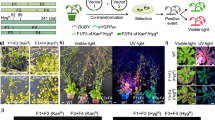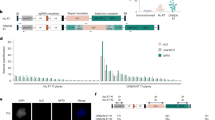Abstract
A derivative of the octopine-type Ti plasmid, pTiB6S3, was constructed in which the TL-DNA oncogenic functions, the TL-DNA right border sequence and all of TR-DNA were deleted and replaced with the kanamycin antibiotic resistance marker from Tn903 (601). The resulting avirulent plasmid, pTiB6S3–SE contains only the TL-DNA left border sequence and a region (1.6 kb) of homologous DNA (LIH) to allow recombination with intermediate vectors such as pMON120 or pMON200. Cointegrate formation between pTiB6S3–SE and pMON200, which contains a chimeric plant kanamycin resistance gene (Kmr), an intact nopaline synthase gene (NOS), a poly linker region to facilitate the insertion of foreign genes into the vector and a functional T-DNA right border sequence, results in the formation of a selectable, avirulent T-DNA. This vector system is referred to as the SEV system (Split End Vector) since the T-DNA border sequences are present on separate plasmids prior to recombination. Plant cells (tobacco, petunia and tomato) transformed with SEV T-DNA are easily identified by their resistance to kanamycin and their ability to synthesize nopaline. A major advantage of the new disarmed system is that all transformed colonies can potentially be regenerated into intact plants that normally express and segregate the inserted foreign DNA sequences.
This is a preview of subscription content, access via your institution
Access options
Subscribe to this journal
Receive 12 print issues and online access
$209.00 per year
only $17.42 per issue
Buy this article
- Purchase on Springer Link
- Instant access to full article PDF
Prices may be subject to local taxes which are calculated during checkout
Similar content being viewed by others
References
Caplan, A., Herrera-Estrella, L., Inze, D., Van Haute, E., Van Montagu, M., Schell, J. and Zambryski, P. 1984. Introduction of genetic material into plant cells. Science 18: 815–821.
Bevan, M. and Chilton, M.-D. 1982. T-DNA of the Agrobacterium Ti and Ri plasmids. Ann. Rev. Genet. 16: 357–384.
Ream, L. and Gordon, M. 1982. Crown gall disease and prospects for genetic manipulation of plants. Science 218: 854–859.
Matzke, A. and Chilton, M.-D. 1981. Site-specific insertion of genes into the T-DNA of the Agrobacterium tumour-inducing plasmid: An approach to genetic engineering of higher plant cells. J. Mol. Appl. Genet. 1: 39–49.
Leemans, J., Shaw, C., Deblaere, R., DeGreve, H., Hernalsteens, J.-P., Maes, M., Montagu, M. and Schell, J. 1981. Site-specific mutagenesis of Agrobacterium Ti plasmids and transfer of genes to plant cells. J. Mol. Appl. Genet. 1: 149–164.
Fraley, R., Rogers, S., Horsch, R., Sanders, P., Flick, J., Adams, S., Bittner, M., Brand, L., Fink, C., Fry, J., Galluppi, J., Goldberg, S., Hoffmann, N. and Woo, S. 1983. Expression of bacterial genes in plant cells. Proc. Natl. Acad. Sci. USA 80: 4803–4807.
Comai, L., Schilling-Cordaro, C., Mergia, A. and Houck, C.M. 1983. A new technique for genetic engineering of Agrobacterium Ti plasmid. Plasmid 10: 21–30.
Van Haute, E., Joos, H., Maes, M., Warren, G., Van Montagu, M. and Schell, J. 1983. Intergenic transfer and exchange recombination of restriction fragments cloned in pBR322: a novel strategy for the reversed genetics of the Ti plasmids of Agrobacterium tumefaciens. The EMBO J. 2: 411–417.
Garfinkel, D., Simpson, R., Ream, R., White, F., Gordon, M. and Nester, E.W. 1981. Genetic analysis of crown gall; fine structure map of the T-DNA by site-directed mutagenesis. Cell 27: 143–155.
Leemans, J., Deblaere, R., Willmitzer, L., DeGreve, H., Hernalsteens, J., Van Montagu, M. and Schell, J. 1982. Genetic identification of functions of TL-DNA transcripts in octopine crown galls. The EMBO Journal 1: 147–152.
Zambryski, P., Depicker, A., Kruger, K. and Goodman, H. 1982. Tumor induction by Agrobacterium tumefaciens: analysis of the boundaries of T-DNA. J. Mol. Appl. Genet. 1: 361–370.
Yadav, N., Vanderleyden, J., Bennet, D., Barnes, W. and Chilton, M.-D. 1982. Short direct repeats flank the T-DNA on a nopaline Ti plasmid. Proc. Natl. Acad. Sci. USA 79: 6322–6326.
Wang, K., Herrera-Estrella, L., Van Montagu, M. and Zambryski, P. 1984. Right 25 bp terminus sequence of the nopaline T-DNA is essential for and determines direction of DNA transfer from Agrobacterium to the plant genome. Cell 38: 455–462.
Klee, H.J., White, F.F., Iyer, V.N., Gordon, M.P. and Nester, E.W. 1983. Mutational analysis of the virulence region of an Agrobacterium tumefaciens Ti plasmid. J. Bacteriol. 87: 153–161.
Ooms, G., Klapwijk, P., Poulis, J. and Schilperoort, R. 1980. Characterization of Tn904 insertions in octopine Ti plasmid mutants of Agrobacterium tumefaciens. J. Bacteriol. 82: 144–150.
Zambryski, P., Joos, H., Genetello, C., Leemans, J., Van Montagu, M. and Schell, J. 1983. Ti plasmid vector for the introduction of DNA into plant cells without alteration of their normal regeneration capacity. The EMBO J. 2: 2143–2150.
Barton, K., Binns, A., Matzke, A. and Chilton, M.-D. 1983. Regeneration of intact tobacco plants containing full length copies of genetically engineered T-DNA, and transmission of T-DNA to R1 progeny. Cell 32: 1033–1043.
Herrera-Estrella, L., DeBlock, M., Messens, E., Hernalsteens, J.-P., Van Montagu, M. and Schell, J. 1983. Chimeric genes as dominant selectable markers in plant cells. The EMBO J. 2: 987–995.
Bevan, M., Flavell, R. and Chilton, M.-D. 1983. A chimeric antibiotic resistance gene as a selectable marker for plant cell transformation. Nature 304: 184–187.
Horsch, R., Fraley, R., Rogers, S., Sanders, P., Lloyd, A. and Hoffman, N. 1984. Inheritance of functional foreign genes in plants. Science 223: 496–498.
Davies, R.W., Botstein, D. and Roth, J.R. 1980. Advanced Bacterial Genetics, p. 116. Cold Spring Harbor Laboratory, Cold Spring Harbor, NY.
Ish-Horowicz, D. and Burke, J.F. 1981. Rapid and efficient cosmid cloning. Nucleic Acids Res. 9: 2989–2998.
Colman, A., Beyers, M.J., Primrose, S.B. and Lyons, A. 1978. Rapid purification of plasmid DNAs by hydroxyapatite chromatography. Eur. J. Biochem. 91: 303–310.
Maniatis, T., Fritsch, E.F. and Sambrook, J. 1982. Molecular Cloning, p. 504. Cold Spring Harbor Laboratory, Cold Spring Harbor, NY.
Adams, S.P., Holder, S.B., Wykes, E.J., Kavka, K.S. and Galluppi, G.R. Hindered dialkylamino nucleoside phosphite reagents in the synthesis of two DNA 51-mers. J. Am. Chem. Soc. 105: 661–663.
Murray, N.E., Bruce, S.A. and Murray, K.J. 1979. Molecular cloning of the DNA ligase gene from bacteriophase T4. J. Mol. Biol. 132: 493–505.
Rogers, S.G. and Weiss, B. 1980. Cloning of the exonuclease III gene of Escherichia coli. Gene 11: 187–195.
Bale, A., d'Alarcao, M. and Marinus, G.M. 1979. Characterization of a DNA adenine methylation mutant of Escherichia coli K12. Mutat. Res. 59: 157–165.
Messing, J., Crea, R. and Seeburg, P. 1981. A system for shotgun DNA sequencing. Nucleic Acids Res. 9: 309–321.
Oka, A., Sugisaki, H. and Takanami, M. 1981. Nucleotide-sequence of the kanamycin resistance transposon Tn 903. J. Mol. Biol. 147: 217–226.
Ditta, G., Stanfield, S., Corbin, D. and Helinski, D. 1980. Broad host range DNA cloning system for gram-negative bacteria: construction of a genebank of Rhizobium meliloti. Proc. Natl. Acad. Science USA 77: 7347–7351.
Hirsch, P. and Beringer, J. 1984. A physical map of pPH1JI and pJB4JI. Plasmid 12: 139–141.
Otten, L.A.B.M. and Schilperoort, R.A. 1978. A rapid micro scale method for the detection of lysopine and nopaline dehydrogenase activities. Biochem. Biophys. Acta 527: 497–500.
Nagao, R., Shah, D., Eckenrode, V. and Meagher, R. 1981. Multigene family of actin-related sequences isolated from a soybean genomic library. DNA 1: 1–9.
Dhaese, P., DeGreve, H., Decraemer, H., Schell, J. and Van Montagu, M. 1979. Rapid mapping of transposon insertion and deletion mutations in the large Ti-plasmids of Agrobacterium tumefaciens. Nucl. Acid Res. 7: 1837–1849.
Southern, E.M. 1975. Detection of specific sequences among DNA fragments separated by gel electrophoresis. J. Mol. Biol. 98: 503–517.
Rogers, S.G. et al. (Manuscript submitted for publication)
Fraley, R., Horsch, R., Matzke, A., Chilton, M.-D., Chilton, W. and Sanders, P. 1981. In vitro transformation of petunia cells by an improved method of cocultivation with A. tumefacins strains. Plant Mol. Biol. 3: 371–378.
Zambryski, P., Holsters, M., Kruger, K., Depicker, A., Schell, J., Van Montague, M. and Goodman, H. 1980. Tumor DNA structure in plant cells transformed by A. tumefaciens. Science 209: 1385–1391.
Depicker, A., Stachel, S., Dhaese, P., Zambryski, P. and Goodman, H. 1982. Nopaline synthase transcript mapping and DNA sequence. J. Mol. App. Genet. 1: 561–574.
Bevan, M., Barnes, W. and Chilton, M.-D. 1983. Structure and transcription of the nopaline synthase gene region of T-DNA, Nucleic Acids Res. 11: 370–385.
Shaw, C., Watson, M., Carter, G. and Shaw, C. 1984. The right hand copy of the nopaline T-plasmid 25 bp repeat is required for tumor formation. Nucleic Acid Res. 12: 6031–6041.
deFramond, A., Barton, K. and Chilton, M.-D. 1983. Mini-Ti: a new vector strategy for plant genetic engineering. Bio/Technology 1: 262–269.
Hoekema, A., Hirsch, P., Hooykaas, J. and Schilperoort, R. 1983. A binary plant vector strategy based on separation of vir- and T-region of the Agrobacterium tumefaciens Ti-plasmid. Nature 303: 179–180.
Bevan, M. 1984. Binary Agrobacterium vectors for plant transformation, Nucleic Acids Res. 12: 8711–8721.
An, G., Watson, B., Stachel, S., Gordon, M. and Nester, E. 1985. New cloning vehicles for transformation of higher plants. The EMBO J. 4: 277–286.
Chilton, M.-D., Tefler, D., Petit, A., David, C., Cusse-Delbart, F. and Tempe', J. 1982. Agrobacterium rhizogenes inserts T-DNA into the genomes of the host plant root cells. Nature 295: 432–434.
White, F., Ghidossi, G., Gordon, M. and Nester, E. 1982. Tumor induction by Agrobacterium rhizogenes involves the transfer of plasmid DNA to the plant genome. Proc. Natl. Acad. Sci. USA 79: 3193–3197.
Thomashow, M., Panagopoulos, C., Gordon, M. and Nester, E. 1980. Host range of Agrobacterium tumefaciens is determined by the Ti plasmid. Nature 283: 794–796.
Author information
Authors and Affiliations
Rights and permissions
About this article
Cite this article
Fraley, R., Rogers, S., Horsch, R. et al. The SEV System: A New Disarmed Ti Plasmid Vector System for Plant Transformation. Nat Biotechnol 3, 629–635 (1985). https://doi.org/10.1038/nbt0785-629
Received:
Accepted:
Issue Date:
DOI: https://doi.org/10.1038/nbt0785-629
This article is cited by
-
An improved ternary vector system for Agrobacterium-mediated rapid maize transformation
Plant Molecular Biology (2018)
-
Conservation of the role of INNER NO OUTER in development of unitegmic ovules of the Solanaceae despite a divergence in protein function
BMC Plant Biology (2016)
-
Genetics, structure, and prevalence of FP967 (CDC Triffid) T-DNA in flax
SpringerPlus (2015)
-
Positive- and negative-acting regulatory elements contribute to the tissue-specific expression of INNER NO OUTER, a YABBY-type transcription factor gene in Arabidopsis
BMC Plant Biology (2012)



